“Creativity – Letting go of comparison” is the 6th guidepost for Wholehearted living identified by Brené Brown (Daring Greatly, 2012, p. 9). Creativity is also one of the factors that supports resilience (reference), which is a sizzling-hot topic in this VUCA environment and time of living with a global pandemic. VUCA is a post-Cold War military acronym that refers to a situation or environment that is Volatile (characterized by rapid change), Uncertain (lack of clarity about the present), Complex (unpredictable situation with multiple key decision factors at play), and Ambiguous (unclear meaning about an event). And living in such a time both requires and stimulates creativity. There’s at least one up-side to the Coronavirus! This all sounds good in theory… and a wide range of emotions emerge in VUCA situations – anxiety, depression, anger, hate, compassion, hopefulness. Creativity can benefit us emotionally, psychologically, cognitively, socially and spiritually.
Why Create? The Benefits of Creativity
The benefits of creativity are numerous. See Sylvia Duckworth’s illustration below for 12 of them.
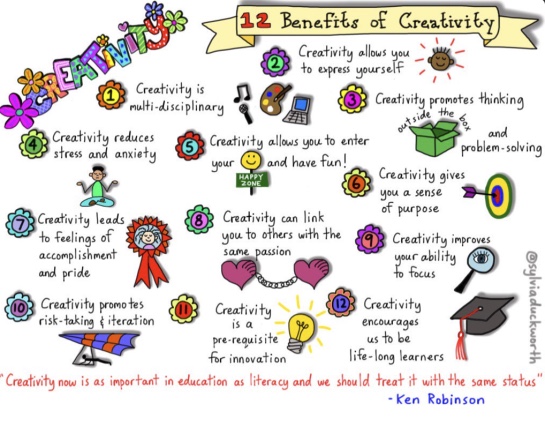
“Being creative gives us opportunities to try out new ideas, and new ways of thinking and problem-solving. Creative activities help us acknowledge and celebrate our own uniqueness and diversity. Creativity encourages self-expression, a way to create something from personal feelings and experiences.” (Life Labs, 2017).
Research shows that creating art and focusing our attention on details offers us a sense of relaxation similar to the experience of meditation. Concentrating on a creative project releases dopamine, a neurotransmitter related to focus, motivation, and reward as well as memory. Creating takes us out of comparison and self-criticism and into a more self-compassionate and positive mindset. Creating distracts us from our worries and helps us focus our attention on positive emotions, which reduces the amount of cortisol (a.k.a., the stress hormone) being released into our bloodstream. Engaging in novel activities and finding new solutions activate different regions of the brain than those involved in routine activities or known problems. This results in new neural pathways and synaptic connections which contributes to cognitive and psychological resilience. Research has also shown that everyday creativity is a means of cultivating positive psychological functioning and is associated with “flourishing”, or having an overall sense of engagement, purpose, meaning, and social connection in our lives (Conner et al., 2016). Creativity improves quality of life in multiple dimensions!
Being creative gives us opportunities to try out new ideas, and new ways of thinking and problem-solving. Creative activities help us acknowledge and celebrate our own uniqueness and diversity. Creativity encourages self-expression, a way to create something from personal feelings and experiences.” (Life Labs, 2017).
Research shows that creating art and focusing our attention on details offers us a sense of relaxation similar to the experience of meditation. Concentrating on a creative project releases dopamine, a neurotransmitter related to focus, motivation, and reward as well as memory. Creating takes us out of comparison and self-criticism and into a more self-compassionate and positive mindset. Creating distracts us from our worries and helps us focus our attention on positive emotions, which reduces the amount of cortisol (a.k.a., the stress hormone) being released into our bloodstream. Engaging in novel activities and finding new solutions activate different regions of the brain than those involved in routine activities or known problems. This results in new neural pathways and synaptic connections which contributes to cognitive and psychological resilience. Research has also shown that everyday creativity is a means of cultivating positive psychological functioning and is associated with “flourishing”, or having an overall sense of engagement, purpose, meaning, and social connection in our lives (Conner et al., 2016). Creativity improves quality of life in multiple dimensions!
Creating Ourselves via Habits of Mind
Viktor Frankl, Holocaust concentration camp survivor and author of Man’s Search for Meaning, wrote: “When we are no longer able to change a situation we are challenged to change ourselves.” When we are faced with new problems without known solutions, we are called to think and act differently. We create ourselves anew – we can choose how we want to BE – more curious, better listeners, kinder towards ourselves and others; as well as choosing what we DO – find new ways of helping each other and staying connected – family Zoom meetings, virtual happy hours, online meetings for work, subject-specific homework packets and teacher-student phone check-ins; decluttering, gardening and doing yard-work, crafting and home projects. Creativity helps us connect to our own aliveness and to our common humanity – also important when “we are all in this together.”
Thinking in more creative ways and thinking outside the box has helped me weather this current “storm”. Try experimenting with these three habits of mind for working with complexity (Garvey-Berger and Johnston, 2015), – the “C” in VUCA, with some examples:
- Asking different questions, e.g.:
- What kind of stories am I telling myself about being creative?
- In what ways do I want to express myself creatively? What story might be more generative (energizing, liberating, enlivening)?
- Who or how do I want to BE at the end of the pandemic? While living in and with it?
- What creative practice can you take on that supports that?
- Taking multiple perspectives, e.g.:
- Who inspires me and who could I be listening to and learning from?
- How might ______ (someone you admire or would like to emulate, such as Nelson Mandela, Pema Chödrön, Julia Child, Brené Brown, Michaelangelo.Georgia O’Keefe) approach this situation?
- Pivoting from What do I want to paint on this rock? To What does the rock want me to paint on it? What wants to happen here?
- Seeing systems, with the following questions directly from Garvey Berger and Johnston’s article (2015):
- What are the forces that are keeping this issue stuck?
- Where are the bright spots: what might be the forces (or pockets) that are moving in a desired direction?
- What guesses do you have about what makes those bright spots more possible? How might you create similar conditions elsewhere or spread the bright spots?
Letting Go… (of old questions, singular perspectives and approaches, and systems)
Take less than 10 minutes to watch an inspiring TEDTalk given by Phil Hansen (TED2013 on the topic of creativity: https://www.ted.com/talks/phil_hansen_embrace_the_shake/discussion?referrer=playlist-237#t-17120 Inspiring because Phil, who was an aspiring artist, developed permanent nerve damage while in art school that caused his hand to shake and affected his creating of art. He took the advice of a neurobiologist to “embrace the shake”. As a result of letting go of the way he had created art before and embracing his limitation – thinking inside the box, his approach to creativity and art changed radically. Phil employed constraints/limits as stimuli for creativity. “Learning to be creative within the confines of our limitations is the best hope we have to transform ourselves and, collectively, transform our world.” (Hansen, 2013). If you’re stuck or feel limited in anyway, this is a story about a life-changing shift that might be life-changing and transformational for you. Enjoy!
What are the habits of mind and other practices that support your creativity? That support creating who and how you want to be moving forward? I’d love to hear your answers and ideas! Email me at: tinageithner@me.com
Resources
Berger, Jennifer Garvey, and Johnston, Keith. Simple habits for complex times. Leader to Leader, April 2015 prepublication version.
Brown, Brené. Daring Greatly: How the Courage to Be Vulnerable Transforms the Way We Live, Love, Parent, and Lead. New York, NY: Gotham Books, 2012.
Conner, Tamlin S., Deyoung, Colin G., & Slvia, Paul J. Everyday creative activity as a path to flourishing. The Journal of Positive Psychology, 2018, 13(2):181-189.
Duckworth, Sylvia. Sketchnote: 12 Benefits of Creativity. Twitter@sylviaduckworth.
Hansen, Phil. Embrace the shake. TED2013. https://www.ted.com/talks/phil_hansen_embrace_the_shake/discussion?referrer=playlist-237#t-17120
Life Labs. The Positive Benefits of Creativity. lifelabs.psychologies.co.uk> 8838-nicola-vanlint> posts. December 14, 2017. Accessed May 29, 2020.
TeachThought Staff. The significant benefits of creativity in the classroom. November 17, 2019. https://www.teachthought.com/learning/innovation-imagination-12-benefits-creativity/
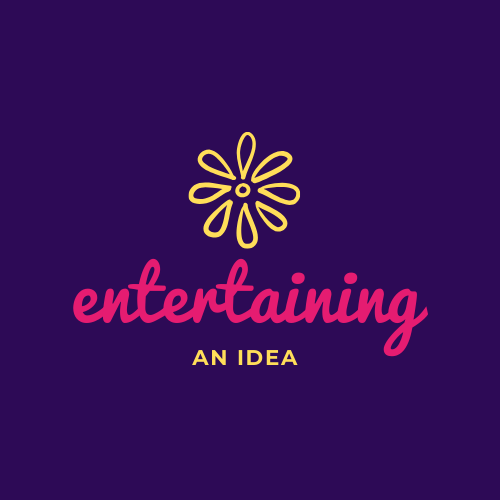

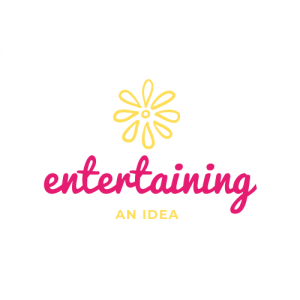

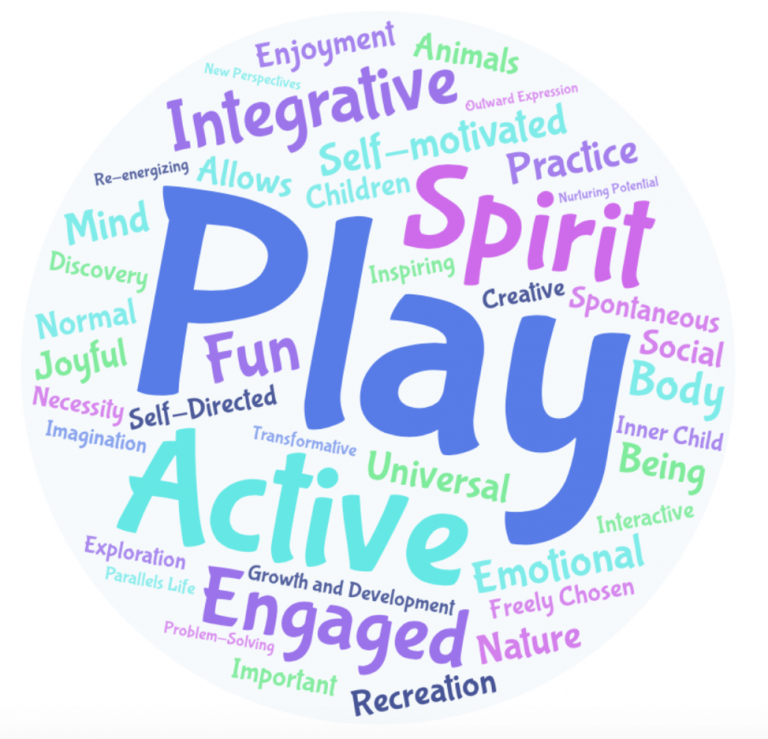
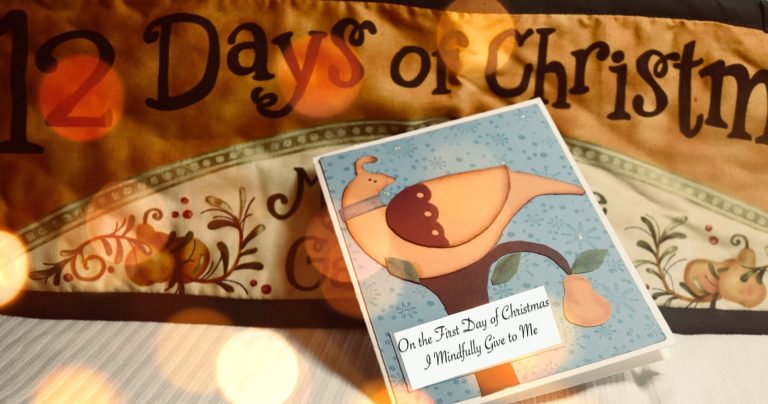

Pingback: GUIDING AN IDEA - Entertaining An Idea